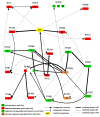Characterization of Nucleoside Reverse Transcriptase Inhibitor-Associated Mutations in the RNase H Region of HIV-1 Subtype C Infected Individuals
- PMID: 29117130
- PMCID: PMC5707537
- DOI: 10.3390/v9110330
Characterization of Nucleoside Reverse Transcriptase Inhibitor-Associated Mutations in the RNase H Region of HIV-1 Subtype C Infected Individuals
Abstract
The South African national treatment programme includes nucleoside reverse transcriptase inhibitors (NRTIs) in both first and second line highly active antiretroviral therapy regimens. Mutations in the RNase H domain have been associated with resistance to NRTIs but primarily in HIV-1 subtype B studies. Here, we investigated the prevalence and association of RNase H mutations with NRTI resistance in sequences from HIV-1 subtype C infected individuals. RNase H sequences from 112 NRTI treated but virologically failing individuals and 28 antiretroviral therapy (ART)-naive individuals were generated and analysed. In addition, sequences from 359 subtype C ART-naive sequences were downloaded from Los Alamos database to give a total of 387 sequences from ART-naive individuals for the analysis. Fisher's exact test was used to identify mutations and Bayesian network learning was applied to identify novel NRTI resistance mutation pathways in RNase H domain. The mutations A435L, S468A, T470S, L484I, A508S, Q509L, L517I, Q524E and E529D were more prevalent in sequences from treatment-experienced compared to antiretroviral treatment naive individuals, however, only the E529D mutation remained significant after correction for multiple comparison. Our findings suggest a potential interaction between E529D and NRTI-treatment; however, site-directed mutagenesis is needed to understand the impact of this RNase H mutation.
Keywords: HIV-1; NRTIs; RNase H; mutations; resistance.
Conflict of interest statement
The authors declare no conflicts of interest.
Figures



Similar articles
-
Genetic diversity and antiretroviral resistance-associated mutation profile of treated and naive HIV-1 infected patients from the Northwest and Southwest regions of Cameroon.PLoS One. 2019 Nov 21;14(11):e0225575. doi: 10.1371/journal.pone.0225575. eCollection 2019. PLoS One. 2019. PMID: 31751428 Free PMC article.
-
Mutations in the thumb-connection and RNase H domain of HIV type-1 reverse transcriptase of antiretroviral treatment-experienced patients.Antivir Ther. 2009;14(2):231-9. Antivir Ther. 2009. PMID: 19430098
-
High resistance to reverse transcriptase inhibitors among persons infected with human immunodeficiency virus type 1 subtype circulating recombinant form 02_AG in Ghana and on antiretroviral therapy.Medicine (Baltimore). 2020 Feb;99(7):e18777. doi: 10.1097/MD.0000000000018777. Medicine (Baltimore). 2020. PMID: 32049783 Free PMC article.
-
Study of the impact of HIV genotypic drug resistance testing on therapy efficacy.Verh K Acad Geneeskd Belg. 2001;63(5):447-73. Verh K Acad Geneeskd Belg. 2001. PMID: 11813503 Review.
-
HIV drug resistance following a decade of the free antiretroviral therapy programme in India: A review.Int J Infect Dis. 2018 Jan;66:33-41. doi: 10.1016/j.ijid.2017.10.020. Epub 2017 Nov 8. Int J Infect Dis. 2018. PMID: 29128646 Review.
Cited by
-
Prediction of the Co-receptor usage of the main worldwide HIV-1 subtypes, CRF, and CRF35-AD in Iranian patients via the five genotypic tools.Biochem Biophys Rep. 2025 Feb 17;41:101939. doi: 10.1016/j.bbrep.2025.101939. eCollection 2025 Mar. Biochem Biophys Rep. 2025. PMID: 40034260 Free PMC article.
-
An Evolutionary Model-Based Approach To Quantify the Genetic Barrier to Drug Resistance in Fast-Evolving Viruses and Its Application to HIV-1 Subtypes and Integrase Inhibitors.Antimicrob Agents Chemother. 2019 Jul 25;63(8):e00539-19. doi: 10.1128/AAC.00539-19. Print 2019 Aug. Antimicrob Agents Chemother. 2019. PMID: 31109980 Free PMC article.
-
Computational strategies to combat COVID-19: useful tools to accelerate SARS-CoV-2 and coronavirus research.Brief Bioinform. 2021 Mar 22;22(2):642-663. doi: 10.1093/bib/bbaa232. Brief Bioinform. 2021. PMID: 33147627 Free PMC article. Review.
-
A Tale of Three Recent Pandemics: Influenza, HIV and SARS-CoV-2.Front Microbiol. 2022 Jun 2;13:889643. doi: 10.3389/fmicb.2022.889643. eCollection 2022. Front Microbiol. 2022. PMID: 35722303 Free PMC article. Review.
-
Identification of HIV-1 Reverse Transcriptase-Associated Ribonuclease H Inhibitors Based on 2-Hydroxy-1,4-naphthoquinone Mannich Bases.Molecules. 2025 Jan 23;30(3):495. doi: 10.3390/molecules30030495. Molecules. 2025. PMID: 39942599 Free PMC article.
References
-
- UNAIDS Global AIDS Update. [(accessed on 7 June 2017)];2016 Available online: http://www.unaids.org/en/resources/documents/2016/Global-AIDS-update-2016.
-
- Department of Health National Comprehensive HIV and AIDS plan statistics; South Africa. [(accessed on 7 June 2017)];2008 Available online: http://www.health.gov.za/edp.php.
MeSH terms
Substances
Grants and funding
LinkOut - more resources
Full Text Sources
Other Literature Sources

